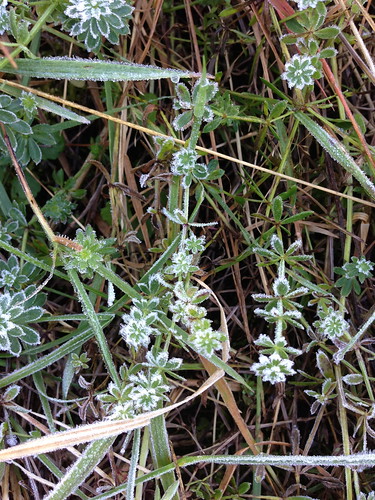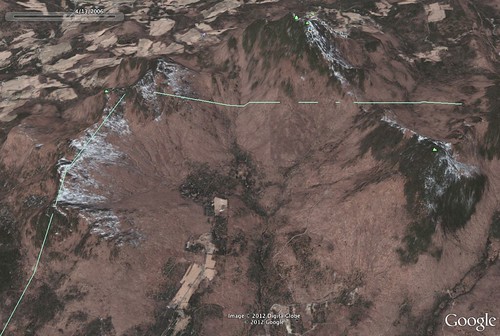
Above: on October 9th, a heavy frost settled over most of the Northeast Kingdom, but not Montpelier, Plainfield, or Barre. These little plants are bedstraw (Galium).
The early season frosts seem a bit random, but they are anything but. We can't "see" temperature changes, although we can notice where frost occurs on marginal freeze nights. There's another way to see the patterns of cold air too - and it is by observing where plants occur on the landscape.

above: red spruce on a talus slope.
Most people have noticed that conifers, like pine and spruce, often occur on cold mountaintops. In Vermont, the most cold-tolerant trees are spruce, fir, paper and yellow birch, and aspen. Of these, the hardwoods are opportunistic and occur in other areas as well, but spruce and fir are almost entirely restricted to areas that get very, very cold - like the steep talus slope high on Umpire Mountain, seen above. Sometimes we also see spruce and fir in somewhat unexpected settings.

The picture above is an oblique, Google Earth view of a valley nestled between Umpire Mountain, Burke Mountain, and Kirby Ridge. The steepness of the terrain is exaggerated in this view. The Burke ski area is visible on the far side of Burke Mountain (center) while the spruce forest in the photo I posted earlier is on the far right of this view, on the steep slopes of Umpire Mountain. Not surprisingly, you can see lots of conifers on these tall mountains, where a lot of snow is also visible (the photo was taken in April of 2006).
You'll also notice something else here though. The conifers aren't restricted to the mountaintop. There are also a bunch of them in the valley. What gives?
Those spruce and fir trees are present in the valley bottom because of cold air drainage. Most of the time, the mountaintops are the coldest parts of Vermont. But, during a cold, still clear night, things change. Heat rapidly radiates away from the mountains, but as air cools, it sinks. Cold air is denser than warm air. Cold air from the mountains surrounding this little valley trickles down to the valley bottom, where it pools. This cold air is no joke. In fact, on a frigid night in 1933, the town of Bloomfield 18 miles to the northeast of this basin measured a low temperature of -50, tied with a more recent record in Maine for the coldest temperature ever recorded in New England. There aren't any weather stations in Victory Basin (the area described above) though, and I wouldn't be surprised if it was even colder there that night.
There aren't many trees that can stand up to -50 degree temperatures, but spruce is one of them. Together with fir and a few other species, the cold air pockets of New England and upstate New York support a natural community called Lowland Spruce-Fir Forest.
View Larger Map
The above map offers a view of Victory Basin, with the lowland spruce-fir forests and associated wetlands clearly visible (this is the same area where I saw a moose a few weeks ago). If you wander north on the above map you will notice a pattern of the darker green conifers being present both in the valleys and on the peaks. If you continue dragging the view north you will come to the Nulhegan Basin, an even larger cold-air drainage area. Both the Victory and Nulhegan basins support species similar to that in the boreal taigas in Canada, ranging from rhodora to the state endangered spruce grouse. Not surprisingly, moose are very abundant in these areas as well. Snowshoe hare and beaver are abundant, and it's possible that even lynx inhabit these icy forests.
Cold air drainage isn't limited to icy climates like Vermont's either. They play a part in the ecology and natural history of the sunny Santa Monica Mountains in Malibu, California as well. I've seen frozen ground and 'frost heaves' in this part of Malibu Creek State Park:
View Larger Map
This is just a few miles from the immediate coastline, where temperatures very rarely drop below 40F and hard freezes may only occur once or twice a century. Stephen Davis of Pepperdine University has found evidence that these cold air drainages strongly affect the vegetation in the area, and he has told me that single-digit (f) temperatures are not unheard of in these isolated areas. I believe it - one spring I lived in Park Service employee housing at nearby Rocky Oaks park, another cold air drainage area, and hard freezes were common on many clear nights well into April. I had to scrape the ice off of my car windshield in the mornings with a credit card because I didn't have an ice scraper. There were even areas of black ice on some of the nearby roads on cold nights after rainstorms.
Malibu's cold air pockets are more defined by an absence than a presence. The ubiquitous laurel sumac shrub that is found over almost all of the Santa Monica Mountains does not occur in cold air drainage areas. It is said that early farmers would only plant citrus where laurel sumac was growing, because it meant frost was very rare.
Next time you are in a small valley or hollow, look at the plants around you, because they may have an icy story to tell.

No comments:
Post a Comment